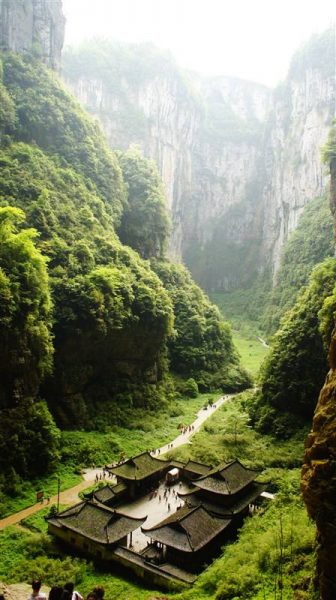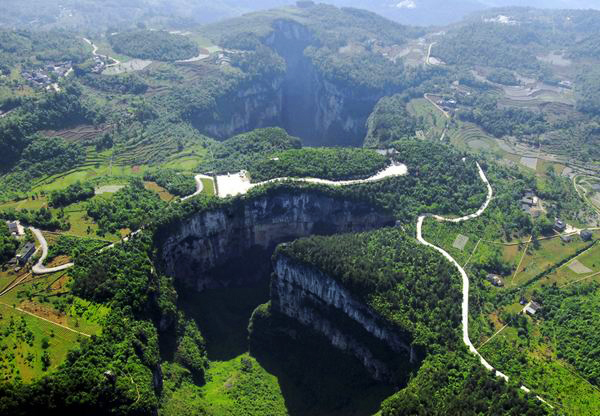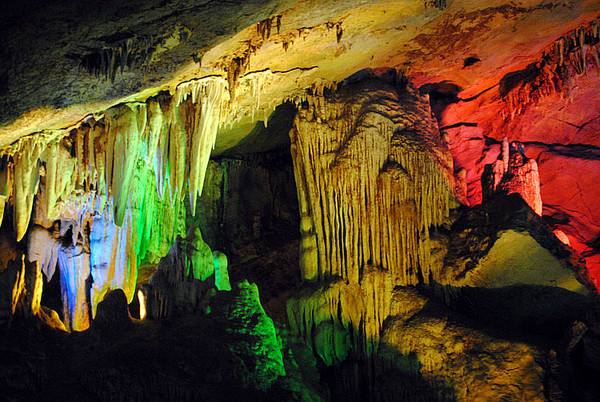
Time has taught us that, in spite of man’s best efforts, nature will always be the greater architect, and never has this been truer than at the Wulong Karst National Geology Park. With its echoing caves, plunging sinkholes, stony ravines, and breath-taking natural bridges, it represents an integral part of the karst landscape in southern China and was designated a UNESCO World Heritage Site in 2007. Located in Wulong County of Chongqing Municipality, the park is divided into three major areas, which each encompass a notable attraction. The first section is home to the Three Natural Bridges; the second contains Qingkou Tiankeng; and the third boasts the magnificent Furong Cave. These spectacular works of nature are proof that three truly is the magic number!
Not far from the delightfully named town of Xiannushan or “Fairy Mountain”, the Three Natural Bridges are a series of three limestone bridges that were formed naturally over time. They are known as Tianlong or “Sky Dragon”, Qinglong or “Azure Dragon”, and Heilong or “Black Dragon” respectively. As the largest natural bridge cluster in Asia, they certainly live up to their grand names! Each bridge rises at an average height of around 200 metres (656 ft.) and spans approximately 400 metres (1,312 ft.) in length. Tianlong Bridge, which features an ancient military outpost directly within its vast arch, is arguably most well-known as the set of Zhang Yimou’s epic Curse of the Golden Flower. The caves nestled within its expanse are maze-like, with the largest stretching to over 400 metres (1,312 ft.) in length.
Qinglong Bridge is considered to be at its most impressive after rainfall, when a waterfall pours over the arch and forms a light mist. As the sunlight reflects on the mist, it creates a miniature rainbow within the bridge’s arch that is said to appear like a dragon ascending to the heavens. Similarly, Heilong Bridge is so-named for the long, dark ravine running under its arch, which resembles a black dragon winding its way out from under the mountains. On top of the bridge, wide tracts of farmland and four delicate springs support an abundance of lush greenery. These bridges are matched in beauty only by the nearby Xiannu or “Fairy” Mountain, a national forest park made up of snow-capped peaks, verdant forests, and alpine meadows. From the fresh greens of spring to the burnished hues of autumn, Fairy Mountain is a popular resort throughout the year for those Chongqing city-dwellers yearning for a taste of nature.

By comparison to the lofty heights of the Three Natural Bridges and Fairy Mountain, the Qingkou Tiankeng Scenic Area may seem like a bit of a downer! It is centred on unique karst landforms known as “tiankeng”, which roughly translates to “sinkhole” or “doline”. These are large depressions or chasms in the earth that have been caused by the surface layer either collapsing or being eroded away. The scenic area is unsurprisingly named after its most esteemed resident: the Qingkou Tiankeng. The tiankeng cluster found in this area is thought to be the only one in the world that was formed by surface water erosion. Each of the five sinkholes in this area has an average diameter and depth of around 300 metres (984 ft.), so watch your step and be careful not to fall in!

Located on the bank of the Furong River, the final scenic area revolves around Furong or “Lotus” Cave. The cave itself is a whopping 2,846 metres (9,337 ft.) in length, with numerous vertical shafts, stalactites, and stalagmites dotted throughout its hollow expanse. These strange rock formations are said to look like frozen waterfalls and petrified palm trees, creating a labyrinthine fairy-tale world populated by grotesque and alien figures. Alongside limestone, the cave also boasts numerous red coral and calcite crystal deposits, which sparkle like precious jewels in the darkness.